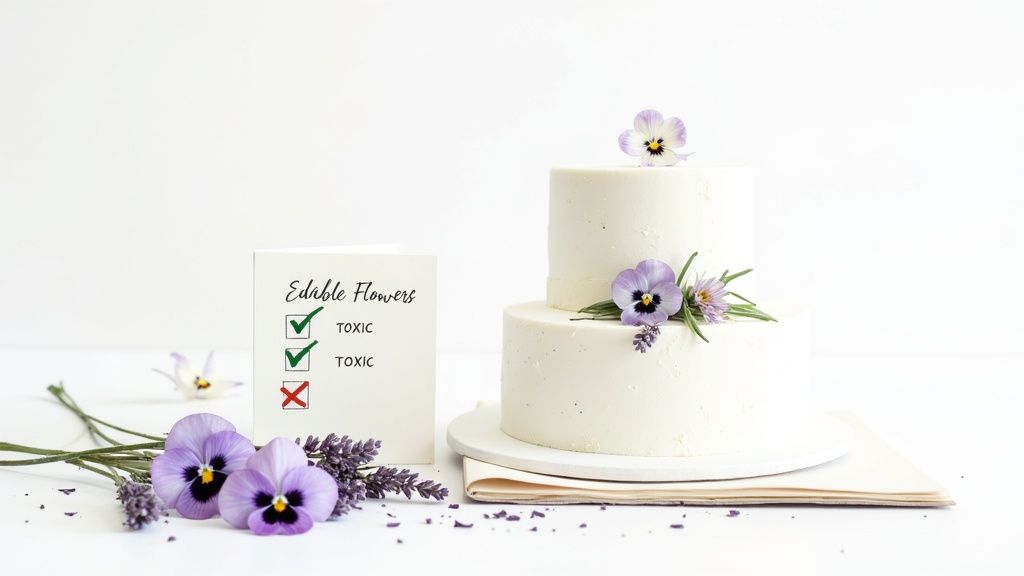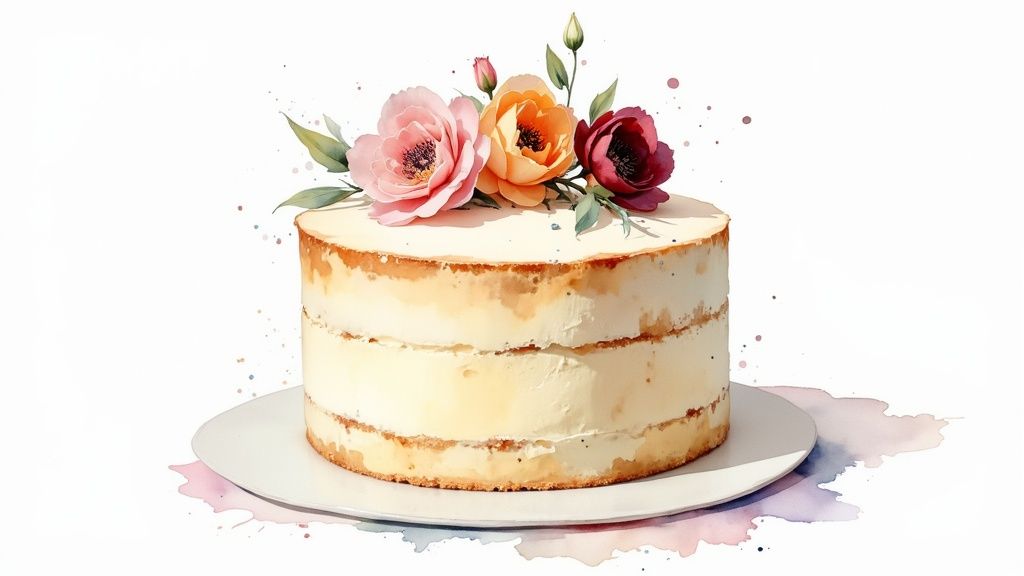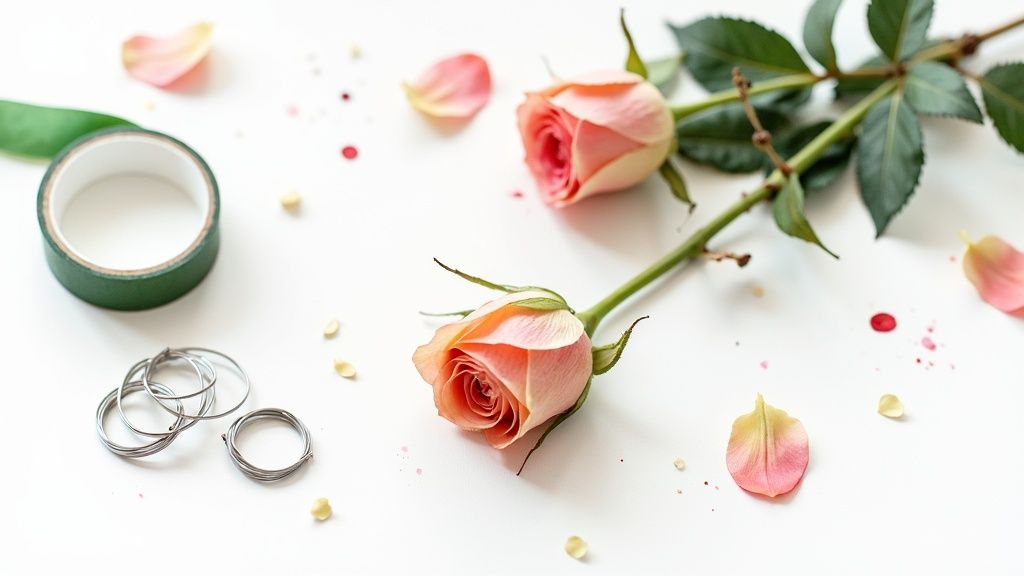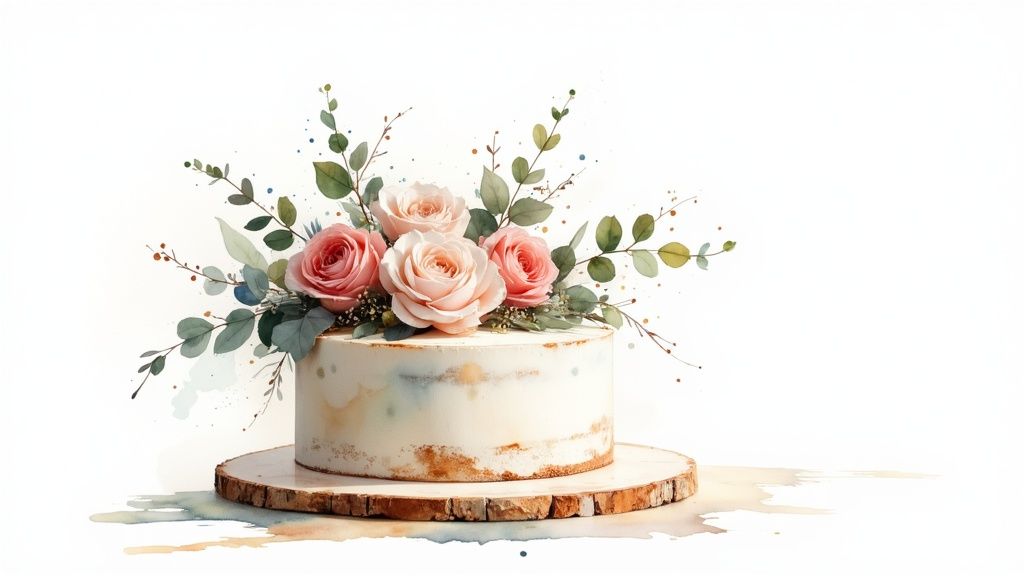Cakes With Flowers Made Simple
Want to add fresh flowers to a cake but worried about safety? You're not the only one. People always ask which flowers are safe to use. It comes down to knowing three categories: edible, non-toxic, and toxic. Getting this right is the first step to a stunning, safe cake.
Using Flowers On Cakes Without The Guesswork

Putting real flowers on your cake shouldn't be a gamble. You need to know what you're working with before a petal touches the icing. Some flowers are fine to eat, others won't harm the cake, and a few are dangerous.
The demand for photo-ready cakes is huge, and flowers are a big part of that. The Australian cake market, valued at AUD 1.39 billion, loves personalized designs. This often means floral arrangements.
Know Your Flower Categories
First, let's break down the flower types. Understanding these differences is critical for food safety.
- Edible Flowers: You can eat these without worry. Think pansies, violas, roses, and lavender. Place them directly on the cake to be eaten with it.
- Non-Toxic Flowers: These aren't for eating but won't cause harm if they touch your cake. Many florist flowers like freesia and baby's breath are in this group. You still need a barrier, but they're generally safe near food.
- Toxic Flowers: This is the "never use" list. Flowers like lily of the valley, daffodils, and hydrangeas are toxic. They should never touch your cake.
The rule is simple: if you're unsure about a flower, don't use it. Check with a reliable source or your florist before decorating. It's not worth the risk.
Quick Guide to Safe Flowers for Cakes
| Flower | Safety Level | Best Use |
|---|---|---|
| Roses | Edible | Petals can be crystallised or placed directly on icing. |
| Pansies | Edible | Great for pressing onto the sides or scattering on top. |
| Carnations | Mildly-Toxic | Use a barrier; petals are edible if grown organically. |
| Baby's Breath | Mildly-Toxic | Insert into posy picks; do not place directly on the cake. |
| Gypsophila | Toxic | Avoid. Often mistaken for Baby's Breath but is toxic. |
| Hydrangea | Toxic | Avoid completely. Looks beautiful but is unsafe for cakes. |
| Eucalyptus | Mildly-Toxic | Perfect for foliage accents, but wrap stems securely. |
This is a starting point. Always research any flower not on this list.
Sourcing Your Flowers Safely
Where you get your flowers is as important as which ones you pick. You need blooms free from pesticides and chemicals. This leaves you with two main options.
Find a trusted organic grower or a florist who guarantees their flowers are unsprayed. Ask them directly. If they hesitate, find another supplier.
The other option is to grow them yourself. This gives you complete control. For more from-scratch ideas, explore our cooking and baking category.
Growing your own ensures your decorations are beautiful and safe. If you prefer to focus on decorating, start with a professional base like a DIY undecorated blank canvas cake. These steps lead to an impressive and safe floral cake.
How to Choose the Right Flowers for Your Cake

The flowers you choose can make or break your cake's look. It's about more than color. You want to match the flowers to the cake's style and the event's vibe.
Think about the occasion. A rustic wedding cake looks great with eucalyptus and wildflowers. A modern birthday cake might use a single dramatic orchid. The goal is harmony between the flowers and the cake.
Matching Flowers to Cake Style and Size
The scale of your flowers must complement the cake's dimensions. Big blooms like peonies can overwhelm a small cake. Tiny blossoms might get lost on a massive, multi-tiered creation.
Here’s a guide to getting the balance right:
- For Tall, Narrow Cakes: Cascading arrangements are best. Flowers like ivy or smaller roses create a downward flow.
- For Wide, Short Cakes: Try a central cluster or a floral wreath on top. This draws the eye to the center.
- For Multi-Tiered Cakes: Use a mix of sizes. Place large blooms at focal points and fill gaps with smaller buds.
A simple trick is to lay flowers next to the cake before placing them. This helps you visualize the final design without damaging the icing. Also consider texture. Ruffled petals add softness to buttercream, while sleek petals complement fondant.
Simple Colour Theory for Stunning Cakes
You don't need to be an artist to nail the color palette. Pick a scheme and stick with it. This creates a cohesive, professional look.
A monochromatic scheme uses shades of one color for a sophisticated design. An analogous palette uses colors next to each other on the color wheel for a harmonious feel. For a bold look, use complementary colors, which are opposites on the color wheel.
This thoughtful design turns a dessert into a centerpiece. For more ideas, see our guide to designing a beautiful floral birthday cake in Melbourne.
The health-conscious trend in Australia is shaping cake design. Clients want cakes that merge beauty with dietary needs. This pushes demand for premium cakes with edible flowers in the AU$4.1 billion industry. You can discover more about this market trend. Choosing the right blooms is the secret to stunning cakes with flowers.
Prepping Your Flowers for Decoration

You've picked the perfect flowers. What's next? You can't just stick them on the cake. Prepping your flowers is a critical step for a professional, food-safe result.
This part isn't hard, but it's non-negotiable. Every bloom needs to be cleaned, trimmed, and sealed. This ensures a stunning finish and keeps everyone safe.
The Cleaning and Trimming Process
First, wash every flower. Gently rinse away dirt, dust, or insects. Submerge the flower heads in cool water and swish them gently.
Lay them on a paper towel to air dry completely. Don't rush this. Moisture is bad for delicate petals and your icing.
Once dry, trim the stems to about 5-7 cm. This gives enough length to secure the flower without being bulky. Use sharp scissors for a clean cut.
Every stem on your cake must be wrapped. This creates a food-safe barrier and stops sap from seeping into your cake.
Creating a Food-Safe Barrier
Floral tape is your best friend here. It's a waxy tape that sticks to itself when stretched, creating a perfect seal.
Start wrapping from the base of the flower head. Stretch the tape as you wrap it tightly down the entire stem. No part of the stem should be exposed.
- For single blooms: A simple wrap is all you need.
- For small clusters: Wire smaller stems together first, then wrap the whole bunch.
- For non-edible foliage: Treat leaves like eucalyptus the same way. Each stem gets wrapped.
This step ensures your cakes with flowers are beautiful and meet food safety standards.
Using Floral Picks for Secure Placement
After wrapping, add another layer of protection: the floral pick. These are small plastic vials with a spike on one end. You insert wrapped stems into the pick.
This method encases the stem, creating the ultimate food-safe barrier. It also provides a sturdy anchor for pushing the flower into the cake without smudging the icing. The pick holds the flower securely.
Using picks also avoids poking many holes directly into your cake. This helps maintain its structure. It's a simple tool that makes a massive difference for flawless cakes with flowers.
Arranging Flowers On Your Cake Like A Pro

Now for the fun part. You have a cake and prepped flowers. It's time to bring your vision to life. A little planning goes a long way. Professional designers use principles to create balanced, focused arrangements.
Common Floral Arrangement Styles for Cakes
The way you arrange flowers changes the cake's mood. A cascade feels grand. A crescent offers a modern touch.
Here are popular floral styles for cakes.
| Arrangement Style | Description | Best For |
|---|---|---|
| Cascade | Flowers seem to spill down the side of the cake, from one tier to the next. | Tall, multi-tiered wedding cakes or dramatic celebration cakes. |
| Crescent | An asymmetrical C-shape arrangement, on the top edge or side of a tier. | Modern, chic cakes. It looks great on both single and multi-tiered designs. |
| Wreath | A complete circle of flowers on top of a cake tier. | Single-tier cakes, or as a classic topper for a larger cake. |
Deciding on a style beforehand gives you a roadmap. It prevents a messy, unplanned look. The secret is creating a clear focal point. Decide where you want the eye to go first and build your design around it.
Building Your Floral Arrangement
With a style in mind, the process is straightforward. Start with broad strokes, then add details. This means layering different flowers to build depth.
Start with your primary flowers. These are the largest blooms, like peonies or big roses. Place them first to set the shape and focal point.
Next, add your secondary flowers. These are smaller blooms that complement the primary ones. Use them to fill out the shape.
Finally, add filler flowers and greenery. Small buds, baby's breath, or eucalyptus leaves work well. Tuck them into gaps to hide mechanics and give the design a finished feel.
For hands-on experience, our beginners workshop on edible floral cupcake bouquets is a great place to learn. You’ll gain practical skills to create stunning arrangements.
Placement and Balance Strategies
Proper placement makes your design look intentional. Start by inserting your largest, focal flowers. This anchors the arrangement and gives you a structure.
Work your way outwards, adding secondary and filler flowers. Rotate the cake as you work to ensure balance from every angle. Step back every few minutes to check the bigger picture.
Remember, less is sometimes more. Don't overcrowd the cake. A well-balanced arrangement on your cakes with flowers will always make a stronger impact.
Keeping Your Floral Cake Looking Fresh
You've placed the last flower. How do you keep it looking perfect? The secret is timing and proper storage.
You're on the clock with fresh flowers. They wilt without water. Keep the time between decorating and serving as short as possible.
The Ideal Timeline for Decorating
Add flowers to the cake on the day it will be served. This ensures they look their best.
If you must decorate the day before, choose sturdy blooms. Roses, carnations, and chrysanthemums hold up well overnight. Delicate flowers like pansies won't.
Storing a decorated cake overnight is possible with care. You need to control the temperature and humidity. This preserves the icing and the flower petals.
Storing Your Decorated Cake
Once finished, the cake goes straight to the fridge. A cool environment, around 2-4°C, slows wilting and keeps icing firm. Keep it away from strong-smelling foods.
Humidity is also important. A dry fridge dehydrates petals. Too much moisture makes them limp. A cardboard cake box creates a balanced micro-environment. These general flower care tips can also be helpful.
Reviving Slightly Wilted Flowers
What if a few petals droop before serving? Don't panic. You can often revive slightly wilted flowers.
Here are a couple of quick fixes:
- A Gentle Mist: Lightly spritz the petals with cool water from a fine mist spray bottle. Don't drench them.
- A Quick Drink: If a flower is very droopy, pull it out. Trim a sliver off the stem and place it in water for 15-20 minutes. Then reinsert it.
These tricks ensure your stunning cakes with flowers look flawless.
Your Floral Cake Questions, Answered
Have a few last-minute questions? That's normal. Nailing the details is what makes a cake great. Let's cover some common queries about decorating with flowers.
Can I Prepare My Floral Cake The Day Before?
Yes, but be smart about it. If you must decorate a day early, use hardy flowers. Roses or carnations can handle a night in the fridge.
Delicate blooms like pansies are a no-go for overnight storage. Save them for same-day decorating.
Once decorated, put the cake in the fridge inside a cardboard box. This protects it from odors and keeps humidity right. It keeps both icing and flowers looking perfect.
How Long Do Fresh Flowers Last On A Cake?
Fresh flowers look best for about 24 hours on a cake stored in the fridge. After that, they start to look tired. They have no water source, so their time is limited.
The rule is to keep the time between decorating and serving as short as possible.
I always decorate a cake on the morning of the event. This small timing adjustment makes a big difference. The flowers are guaranteed to be at their most vibrant.
Are All Parts Of An Edible Flower Safe To Eat?
No, and this is important. "Edible" doesn't mean you should eat the whole thing.
For most flowers, like roses or pansies, you eat the petals. For roses, snip off the bitter white base of the petals. Discard the stems, pistils, and stamens.
Here’s a quick guide:
- Pansies and Violas: The entire flower is edible.
- Roses: Stick to the petals only.
- Lavender: Use the fragrant buds, not the stems or leaves.
Always research the specific flower you’re using. Getting this right ensures everyone has a safe experience.
Critical advice: only use flowers you are 100% certain are edible and grown without pesticides. If you have any doubt, treat the flower as a non-toxic decoration. Create a food-safe barrier between it and the cake. This final step is key to mastering cakes with flowers.
At Amour Desserts, we create stunning handcrafted cakes for every occasion, from birthdays to weddings. If you're in Melbourne and need a beautiful centrepiece for your next celebration, explore our creations and enjoy next-day delivery. Discover your perfect cake at https://amourdesserts.com.au.
